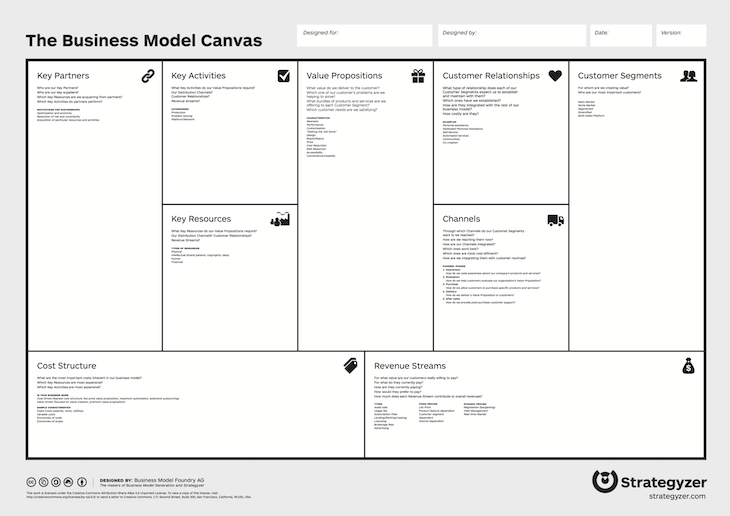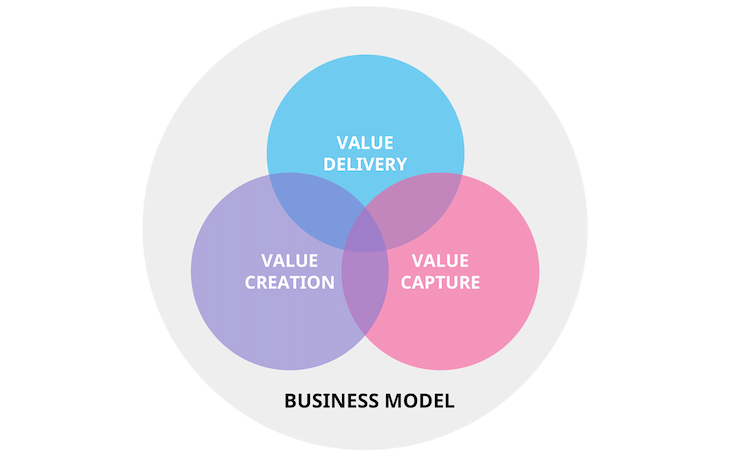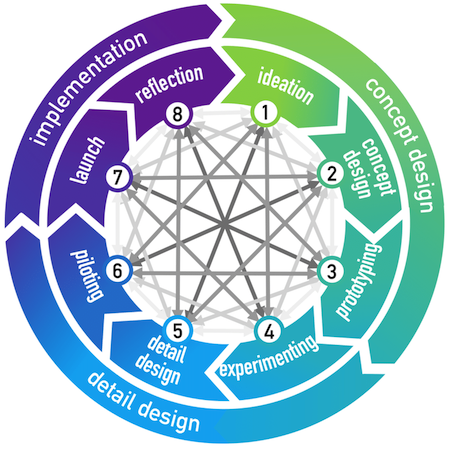In an ever-changing world, business model innovation is something every product manager and entrepreneur should focus on.

Business models that were solid a few months back might be irrelevant today, especially if we look at ever-increasing technological advances. If I had a penny for every business model that has had to pivot due to the advent of ChatGPT, I could retire today.
In this guide, I’ll show you how you can demystify business model innovation by simply asking the right questions.
Let’s start with a high-level overview of what a business model actually is. You’ve probably already seen Strategyzer’s famous business model canvas at least once:

This business model canvas is one of the most common approaches to describing a business model. It includes answers to nine key questions:
If you can get a good answer to all these questions, the overall strategy for your business is solid and self-supporting.
However, the business innovation canvas is just a template. Depending on the maturity of your company, you might need something more lightweight or more robust.
Ultimately, what you need is clarity regarding three critical areas of business operation:

In this article, I’ll focus on the more lightweight approach to business model innovation. It’ll make it more applicable for product managers, who often work only on a product-oriented part of the business model.
Building a business model is similar to everything we do in a product and agile environment. Any guesses?
Yes! We do it iteratively!
In the past, we often worked thoroughly to establish a very detailed business model, probably got a company loan for that, and then spent years executing that model. In the modern world, this approach doesn’t work. Things just change too fast.
Today, business models are not planned; they are discovered. The best approach is to adjust, inspect, and adapt your business model iteratively:

That’s what business model innovation is. It’s a never-ending, iterative process of discovering the best business model given current micro and macro circumstances.
Now let’s try to put the theory into practice. Although there is no “right” approach to iterating on one business model, the lightweight process I prefer involves repeatedly asking three high-level questions:
This part is the most well-known to product managers. To some extent, PMs are hired to focus chiefly on this area of the business model.
Start by visualizing your current value creation process. I like to use a double-layered value proposition model for that (my own framework).
A core value proposition includes:
A category value proposition includes:
Once you have visualized your business model, start challenging it. Use quantitative data, qualitative knowledge, and market expertise to determine how to deliver more value to the market.
The most common approaches to delivering more value include:
What you should focus on depends heavily on the data you have and the context you operate in. But if I were to give a universal tip, focus on properly balancing small bets (improving the current business model) and big bets (pivoting the business model) for the most optimal outcomes.
Innovating on value distribution is all about searching for the most optimal channel for acquiring users and maximizing that channel’s potential.
Let’s assume you acquire users through LinkedIn ads (performance marketing). You should revisit this strategy regularly and ask yourself two questions.
My main tip here is the same as in the previous chapter: in an ideal scenario, you would continuously improve on both your current growth channel (small bets) while also exploring other growth channels (big bets) — especially if you haven’t reached product-channel fit yet.
Capturing value might sound fancy, but let’s be honest — in most cases, it’s all about generating revenue.
You should regularly revisit how your product and business generate money from its operation. While the exact questions you should be asking yourself depend on your particular model, the four questions I believe every PM should ask themselves regularly are:
It’s a big question. If you are a subscription product, should you be a subscription product? Maybe you should try ad-based revenue, or combine both?
The way you charge is more important than how much you actually charge. Ideally, you should charge per value received (i.e., the number of transactions). Or, if this is impossible, per some proxy metrics (e.g., the number of seats), or a flat monthly fee. Is it the best way?
Different segments have different willingness to pay and price sensitivity. Finding the best price points to charge requires a lot of quantitative research, but it’s worth it.
In the end, increasing the price by 10 percent might be the fastest way to grow revenue or the fastest way to lose all your customers.
If you have a more mature product with various types of plans, consider bundling/unbundling them and experimenting with different plan settings.
Maybe there’s a gap between your tier 1 and tier 2 offering, leaving a lot of money on the table. Or, perhaps you should add to your most premium offering a standalone, pay-per-use feature.
Sometimes, moving a feature from one plan to another can knock your revenue through the roof.
Now that we’ve thoroughly explored the concept of business model innovation, let’s dive into some real-world examples. These cases highlight the impact that innovative business models can have on a company’s success or failure.
One of the most well-known examples of successful business model innovation is Netflix. The company started as a DVD rental service by mail, but it quickly identified the potential of streaming technology.
By shifting its focus to on-demand streaming, Netflix transformed the way we consume entertainment and effectively disrupted the traditional cable TV industry. This strategic shift allowed the company to grow exponentially and become a global entertainment powerhouse.
By leveraging then-nascent mobile app technology, Uber created a platform that connects drivers with passengers looking for a ride. This peer-to-peer model revolutionized the transportation industry, challenging traditional taxi services and expanding to other services like food delivery.
Although Uber faced regulatory hurdles and controversies along the way, it remains a prime example of how business model innovation can create a new market.
On the flip side, Blockbuster’s failure to innovate its business model serves as a cautionary tale. As a movie and video game rental chain, Blockbuster was once the go-to place for home entertainment. However, the company failed to adapt to the digital age and recognize the potential of streaming services, ultimately leading to its decline.
Had Blockbuster been more agile and open to business model innovation, it might have remained a significant player in the entertainment industry.
LEGO, the iconic toy company, faced near bankruptcy in the early 2000s due to a lack of focus and an overly complex product portfolio. To turn things around, LEGO embraced business model innovation by refocusing on its core product — the beloved plastic brick — and expanding into new markets.
By capitalizing on brand partnerships, digital gaming, and even theme parks, LEGO successfully transformed its business model and remains a beloved brand worldwide.
Zipcar was an early pioneer of the car-sharing model. By allowing members to rent cars by the hour or day, Zipcar offered a convenient and cost-effective alternative to traditional car ownership.
Although the company faced challenges and was eventually acquired by Avis Budget Group, its innovative business model inspired a wave of car-sharing services that continue to reshape urban transportation.
Business model innovation sounds like a big, daunting endeavor. In reality, though, it can be as complex or as straightforward as you want it to be.
I believe in simplicity. The more robust the innovation process is, the more neglected and deprioritized it often gets.
When it comes to business model innovation, I encourage you to think about it simply as an iterative process of asking the right questions. Start with the three main questions:
Then, step by step, go a bit deeper and ask more detailed questions.
On the one hand, you must innovate your business model in a conscious, iterative manner to stay competitive. But on the other hand, you don’t have to do it all at once. In fact, you shouldn’t.
Revisit the main questions and focus on the part of your business model that requires the most attention in your current context. Trying to innovate on a business model as a whole is a fool’s game.

LogRocket identifies friction points in the user experience so you can make informed decisions about product and design changes that must happen to hit your goals.
With LogRocket, you can understand the scope of the issues affecting your product and prioritize the changes that need to be made. LogRocket simplifies workflows by allowing Engineering, Product, UX, and Design teams to work from the same data as you, eliminating any confusion about what needs to be done.
Get your teams on the same page — try LogRocket today.

A practical five minute revenue estimation method to help product managers compare ideas, drop low impact features, and prioritize smarter.

A practical guide for PMs who want to stop being bottlenecks, delegate smarter, and lead teams effectively with a clear ownership framework.

Stop letting unreliable data block features. Treat data as inventory to track quality, ownership, and ship with confidence.

Learn why slide decks slow teams down and explore better tools like whiteboards, PRDs, and prototypes to improve collaboration and alignment.